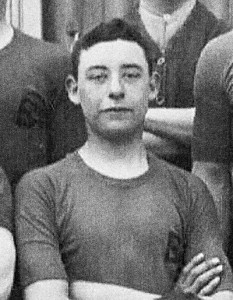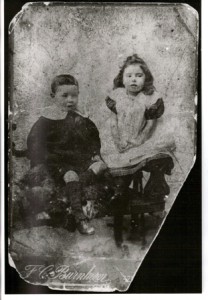From Lce Cpl Crawshaw, E Coy, 1st Bn Dorsets, Blackdown
13-8-12
Dear Mable
I received your welcome letter, and am glad to hear that you enjoyed yourself + also May. Till I am sorry that I am unable to get away for the fortnight leave but I am going to get a weekend from the 4th of September so will hope to spend a few hours with you then. I notice that you never told me Doris was home on a holiday but I guessed it, for her little letter which she wrote to me tell her she likes her plumes too much. How long is Doris home for, for I should like to see her, did you see your photo in those PC I sent home shourly you can recognise your big hat + what about sending me one of your and also Mays especially where you was taken in the water (not much) Remember me to Mother and tell mar I hope to see her soon + also Pups (?). Is Muffit still at that same place where you gave me the address off.
Now Till I hope you will send me photo of May and yourself and write back soon don’t forget dear. The weather is very cold + also raining. How many more young fellows will you have before you get the right one, I think the best youngman that you ever had was (B Spenc—r see any green) No that’s not my wedding I was going to, I have got too much sence to get spliced, I am waiting for you so that I can come round + have a cheap tea. Remember me to Horace and also your bloke. Hoping you all at home are in the best of health + still smiling. Don’t forget to let me know if Muff is still at the same place. That’s all the news at present hoping to hear from you soon love, and not much of the Joe peachie.
I remain
Your loving raspberry
Frank
For Joe xxxxxxx
Don’t forget the photos and write back soon
Introducing the Crawshaws
Frank’s parents, Frank Crawshaw and Ada Webster were married in 1890 in Camberwell Parish church, St Giles. Both were living in Dulwich Village at that time, according to the marriage certificate.
Ada was born in Southwark in 1870. Her parents were Matthew Webster, a machine pattern cutter from York, and Phoebe Oakley. Southwark was an slum housing area blighted with high levels of poverty and crime
Frank Crawshaw senior was originally from Norfolk. The 1891 census sees him working as a pawnbroker’s assistant, living at 252 Wandsworth Road. I couldn’t find any mention of Ada at this time in the records I have access to.
Brixton life
Three years later, however, they are living together at 21 Combermere Road (street view below) in Brixton. It’s now a rather lonely little house with a reinforced front door. Frank was born in 1893 and a year later Mabel came along.
In the 1901 census we find Frank and Mable living at 48 Bellefields Road (street view below) in Brixton with their father Frank, mother Ada and a lodger called Henry Sheppard.
Frank senior was now a brewer’s clerk, possibly at the Youngs Brewery in Wandsworth or the Red Lion Brewery in Lambeth, now the site of the Royal Festival Hall. Interestingly the lion which once stood on top of the brewery’s entrance archway can now be found standing on a plinth on the south side of Westminster bridge. The brewery itself was destroyed by bombs in the Second World War.
Frank and Ada Crawshaw were both certainly from humble backgrounds, but the Brixton properties they lived in seem comfortable enough. They were probably far better off in Brixton than the cramped housing of Southwark and Bermondsey.
Brixton was born out of the development of south London in the second half of the 19th Century. Vauxhall Bridge opened in 1816, opening up the farms and market gardens of South London to developers. The Chatham Main Line brought the railway through Brixton in 1862. Large houses and middle class artisan developments sprang up around a busy market and commercial centre. As leases got shorter the middle classes moved out and, by the early 1900s, larger properties were being split into flats allowing working class families to live within easy commuting distance of the Capital, away from the squalor of the inner city slums.
The letter and the language
Frank’s first letter mentions their sister Doris. She was born in 1902 and in 1912 seems to be living away at school. Is the eight year gap between children significant? We’ll find out more about the state of the Crawshaw’s marriage in later letters.
Frank shows off his sense of humour in this first letter. He mentions a previous suitor of Mable, Ben Spen—r (I am guessing Ben Spencer but don’t know why he censors himself) and follows it up with a comment “see any green”. “See any green (in my eye)” was a popular english phase and probably meant that he is not as naive as she thinks. He enjoys pulling his sister’s leg about her love life.
Frank ends the letter with the phrase “not so much of the Joe Peachie”. I’ve found one mention of Joe-Peachey in the American magazine Boy’s Life in February 1921. This seems to echo the meaning we know today as everything is fine. So to use it in almost a negative way is perplexing. Does anybody know the origins of this phrase?
I love the phrase “your loving raspberry” he uses to sign off the letter with. I think I’m going to use it in emails to clients.
He talks about photographs long since lost. Who was May? I have yet to find out, but his “not much” aside, when mentioning a photo of her and his sister (possibly swimming?) in water, suggests that she was a girlfriend, rather than a relative.
Horace and Joe are also mentioned in the letter but I cannot match their names to anyone in my rather spindly family tree.
My great uncle Geoff remembers in his notes that he had an auntie Muff as a child. Muff is also mentioned as Muffit. I am guessing that they are one and the same person. I wonder if she is a sister of Ada Webster?
Perhaps I’ll find out in the next week from other members of my far flung family. Until then, I remain your loving raspberry. JE x
Next week
We’ll meet more members of the family and have a look at some of the consumer products of the time.

